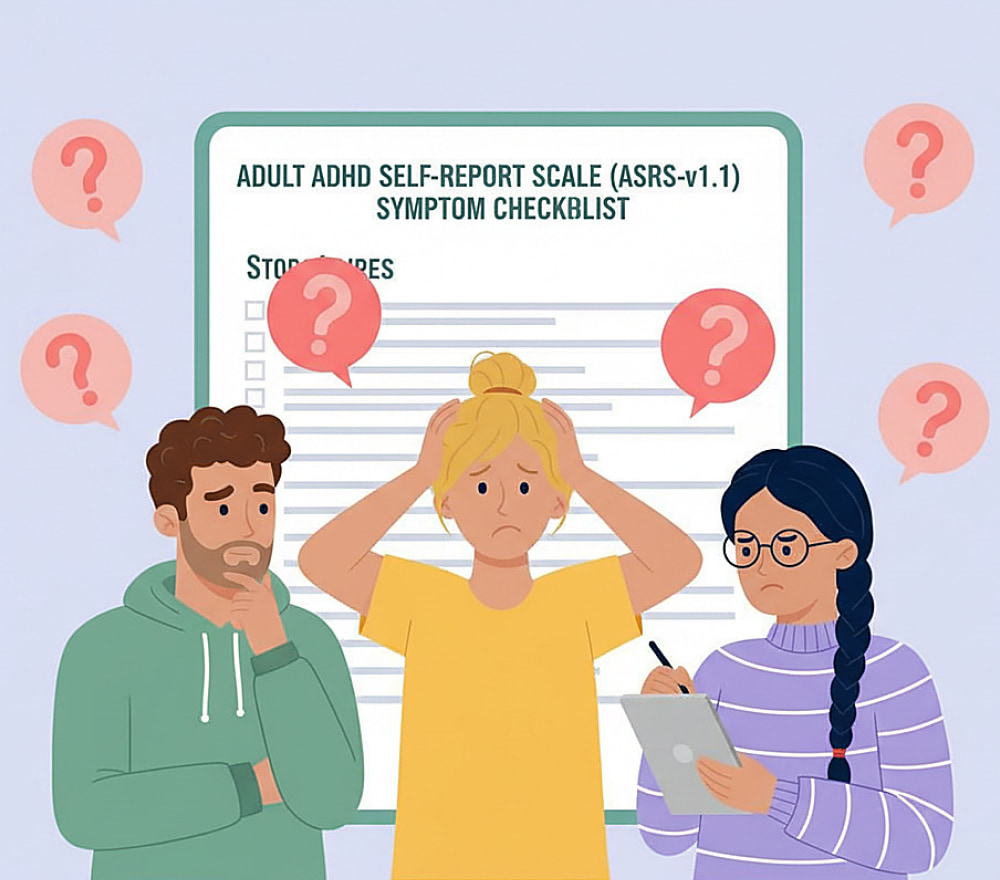The ADHD ASRS Test Explained: Symptoms, Scoring, and Use

Take ASRS Assessment for ADHD
Get StartedThe ASRS ADHD assessment has become an invaluable tool for individuals suspecting they have Attention Deficit Hyperactivity Disorder. Designed primarily for adults, this self-report scale offers insights into symptoms that might have been unnoticed during childhood. The assessment plays a crucial role in initiating conversations with healthcare professionals, guiding them towards accurate diagnoses and effective management strategies.
What Is the Adult ADHD Self-Report Scale?
The adult ADHD self-report scale ASRS is a diagnostic questionnaire designed to aid in identifying ADHD symptoms in adulthood. While ADHD is often associated with children, many adults continue to face challenges linked to ADHD or may not have been diagnosed earlier in life. The scale offers an effective means of understanding symptoms and their impact on daily activities.
In evaluating symptoms, the tool is neatly bifurcated into two distinct sections. The first section, Part A, is specifically designed to identify the most prevalent and predictive symptoms of ADHD. The second part, Part B, delves deeper by investigating additional symptoms that may not be as immediately apparent. This tool's straightforward and clear questions enable individuals to introspect and analyze their daily experiences and behavioral patterns. It's crucial to understand that while the adult ADHD self-report scale scoring can provide initial insights, it is fundamentally a preliminary screening tool. It should not be mistaken for a professional diagnosis, which mandates a more comprehensive evaluation.
Benefits of Using the ADHD Self-Report Scale
The ADHD adult self-report helps individuals identify potential traits associated with ADHD, leading to better self-awareness. This can foster improved interactions in both personal and professional environments. Using the ASRS can initiate discussions that result in lifestyle changes or medical interventions, ultimately enhancing life quality.
- Quick and easy to complete.
- Helps in recognizing symptoms that impact life.
- It can be used as a preliminary step before seeking professional advice.
For adults who suspect they might have ADHD, taking the time to complete the ASRS can be empowering. This actionable data can be the first step in a journey towards managing symptoms effectively.
How to Score the ASRS
Scoring the adult ADHD self-report scale ASRS is straightforward. Each item is rated on a scale, and certain thresholds suggest the need for more detailed evaluation. The first four items in Part A are the most critical, with higher scores signaling a stronger likelihood of ADHD symptoms. It's crucial to interpret the scores correctly and consider them as a component of a broader diagnostic process.
| Response Category | Score Value |
|---|---|
| Never | 0 |
| Rarely | 1 |
| Sometimes | 2 |
| Often | 3 |
| Very Often | 4 |
Understanding the ADHD self-report scale scoring provides context for individuals to seek further evaluation from medical professionals. When using the ASRS, remember that context and personal history are essential factors that affect the interpretation of scores.
Components of the Adult ADHD Self-Report Scale
The adult ADHD self-report scale ASRS-v1.1 is an updated version intended to provide a more nuanced evaluation. This version includes a symptom checklist that captures a wide range of behaviors and experiences commonly associated with ADHD.
The checklist items focus on areas such as attention span, impulsivity, and time management. Evaluating responses in these areas allows individuals to pinpoint specific difficulties they might be encountering. Awareness of these elements supports productive discussions with healthcare providers and paves the way for targeted intervention strategies.
Frequently Asked Questions
Here are some of the most common questions about the ASRS and its application:
- How is the ASRS assessment for ADHD conducted?
The ASRS assessment for ADHD is a self-administered questionnaire that evaluates everyday experiences and behaviors linked to ADHD symptoms.
- Is the Adult ADHD Self-Report Scale Symptom Checklist reliable?
Yes. The adult ADHD self-report scale symptom checklist is a validated tool widely used by professionals to measure ADHD symptoms in adults.
- What is the purpose of the Adult ADHD Self-Report Scale ASRS v1.1 scoring?
The ASRS v1.1 scoring system helps individuals and healthcare providers assess symptom severity and determine the need for further evaluation.
- Can the ASRS replace a professional diagnosis?
No. The ASRS ADHD scale is a screening tool and should always be supplemented with a comprehensive clinical evaluation by a healthcare professional.
- How often should one take the ASRS?
The ASRS self-report scale can be used periodically to monitor symptoms, but any significant changes should be discussed with a healthcare provider.
The ADHD self-report offers a structured pathway for individuals to explore ADHD symptoms, promoting better understanding and collaboration with healthcare providers for effective management strategies.
